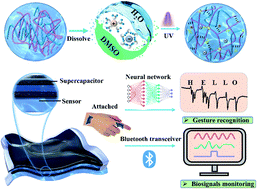Environment stable ionic organohydrogel as a self-powered integrated system for wearable electronics†
Abstract
Intelligent flexible sensors that are comfortable to wear and have self-powered properties are primary candidates for next-generation wearable electronics. Nevertheless, most current flexible sensors cannot work independently, they have to rely on external power. Herein, we report a flexible sensing device that is able to reliably and stably monitor human motion with successive self-powering. The device consists of a supercapacitor as a power source and a strain sensor. An ionic hydrogel was used either as the electrolyte for the supercapacitor or as the functional element for the sensor. Thanks to the superior electromechanical and electrochemical properties of the hydrogel, when used as the electrolyte, the supercapacitor delivers over a wide voltage window (0–2.5 V), and exhibits superior energy density (81.46 mW h cm−2), and power density (2500 mW cm−2). The ionic hydrogel electrolyte also exhibits environmental durability and strain-resistance, demonstrating its reliability under deformation. Strain sensors based on such ionic organohydrogels operate over a wide working range (0–1000%), with high sensitivity (gauge factor = 6.04), and durability. Such a compact wearable sensing system presents potential applications in health monitoring by detecting motion precisely and rapidly. When machine learning is combined into a wearable sensing system, the intelligent device offers new prospects for tackling challenges in wearable electronics.



 Please wait while we load your content...
Please wait while we load your content...